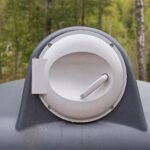These two DSLRs were introduced the same time, April 22, 2005. They are both consumer-level cameras, so why release them on the same day?
If you look at the list of Nikon DX cameras and focus on the dates, you’ll see that the company has by and large kept to a pretty regular schedule of introducing new cameras.
There are a few exceptions, of course. One obvious one is that the D70s and the D50 were introduced the very same day in 2005.
Given that the D50 was then a brand-new camera, and the D70s a very minor update to the D70, introduced in early 2004, this might seem odd.
Ken Rockwell has a detailed comparison between D80, D70/s and D50.
I happen to have all these cameras (well, D70s, not D70), and the differences in size and weight are not that noticeable. The D80 and the D70s are almost the same weight, the D50 is lighter. I prefer the D80 in my hands. But no doubt, the D50 and a small prime like the Nikon AF 24mm f/2.8 is a small and light combo for excursions.
That the D70/s is an older model than D50 and D80 is clear, not the least because it takes Compact Flash cards instead of SD cards.
When it comes to picture quality it’s hard if not impossible to see a difference, at least I can not. Although I can’t find any evidence of it, it seems they have exactly the same sensor. If you face a choice of getting one or the other, it’s more likely other things than picture quality that will decide. Or why not get both, there are still plenty of them on the used market, and they cost very little.
After all of that, are we any closer to answering the question, what was Nikon thinking?
The D50 is the newer camera. The D70s has the edge in a few areas, like 1/8,000 top shutter speed, compared to 1/4,000. Perhaps Nikon saw the D70s as more of a prosumer camera, while the D50 was clearly consumer. The D70 was at the time just over a year old, and by all accounts a big success for Nikon, so I guess it makes sense that they wanted to build on that success with the D70s. And around eighteen months later came the D80, perhaps they brought out the D70s as a bridge to the D80, possibly waiting for some technology to get ready.
That is supported by this article, which states:
In spite of my rave review of the entry-level model, I preferred the D70s for three reasons. One, its faster (3 vs. 2.5 fps) continuous framing rate was a valuable benefit while shooting fast action. Two, when working in Manual mode, I found the two (vs. one) input dials far more convenient. And finally, I appreciated the depth of field preview control and the grid lines on the viewing screen on the D70s. The latter are useful as an aid to composition and also provide guidance for keeping both horizontal and vertical lines straight.
That points to the D70s being seen as a sort of prosumer model, and could be the reason Nikon kept the D70 alive by adding a few things to it.
It sure would have been interesting to be in on the meetings where Nikon people discussed and decided on the D70s and the D50.



